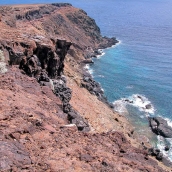Geology of the Salvage Islands
This group of islands, islets and rocky outcrops form the emergent part of a single volcanic edifice, the base of which is located at 3,500 m depth and which gradually grew through the accumulation of materials from a sequence of submarine eruptions. The islands follow a northeast-southwest alignment, with one island at one tip and the remaining two at the other. Selvagem Grande is the easternmost island and is located at 10 miles from Selvagem Pequena. Between the two the seafloor drops away to a depth of more than 500 m. Selvagem Pequena and Ilhéu de Fora, the westernmost islet, formed a single island until a few thousand years ago, when the sea level was much lower than now. Today they are separated by a narrow sound that barely reaches 20 m depth.
Exact data on the age of the islands are lacking, but the geology indicates that they are rather old and are estimated to have emerged during the Lower Miocene, probably in the same period as Lanzarote, Fuerteventura (Canaries) and Porto Santo (Madeira).
The base of Selvagem Grande is formed by a complex agglomeration of compact tuff that includes phonolitic volcanic and plutonic rocks, crisscrossed by basaltic and phonolitic dikes and pinnacles. This mass rises 70-80 m above the sea and rests on a layer of Miocenic calcareous materials several metres’ thick that contain different land and sea fossils. The upper section of the island is covered with pyroclastic rocks and basaltic lava flows of ancient submarine eruptions and more recent eruptions from the peaks of Atalaia, Tornozelos and Inferno, which are, in reality, old volcanic cones.
The fossil record of the archipelago of the Savage Islands is the most scant of all Macaronesia, not only because of its small surface area but because of limited research on existing paleontological sites. The oldest fossils are foraminiferans found in the limestones that fill fractures in the basal agglomerates. Studies into the association of microfossils places these limestone materials in the Oligocene or Lower Miocene.
A packet of sedimentary materials that covers a large area of Selvagem Grande tops these basal rock deposits, which are composed of a lower marine conglomerate of volcanic pebbles in a sandy matrix that contains fossils of molluscs characteristic of the Miocene (Nerita martiniana, Megaxinus bellardiana, etc.). This conglomerate is topped by a layer of calcarenitic sands that contain bone and egg remains belonging to at least three different species of seabirds, including the Manx shearwater (Puffinus puffinus).
Finally, sites that date from the Quaternary contain great accumulations of organogenous sands (some already cemented), in which appear important concentrations of terrestrial gastropod shells (Theba pisana, Theba macandrewiana). As in the other archipelagos of Macaronesia, changes in sea level caused climatic variations during the Pleistocene, which are reflected on the coastline of the Savage Islands. Unlike the Canaries and Madeira, however, these sites have no species associated with warm waters or large accumulations of calcareous algae (rhodoliths), another indication of a higher sea temperature. Nevertheless, the species Acanthina dontelei (dedicated to Canary Islands geologist Telesforo Bravo), a gastropod that has subsequently been found in several sites of the Upper Pleistocene in the Canaries, has been described in Savage Islands deposits for the first time.













